Examining Modulations of Internal Tides within An Anticyclonic Eddy Using a Wavelet-Coherence Network Approach
Abstract
:1. Introduction
2. Materials and Methods
2.1. Glider Measurements
2.2. Wavelet Analysis Methodology
- Generation of a Gaussian white noise time series to match the length of the original data.
- Calculation of the continuous wavelet (Fourier) transform of the noise to extract its phase.
- Combination of the randomized phase and the wavelet transform modulus of the original signal to produce a surrogate time–frequency distribution.
- Reconstruction of a non-stationary surrogate time series by taking the real part of the inverse wavelet transform.
- Rescaling of the surrogate to match the distribution of the original time series.
2.3. Network Construction
2.4. Network Metrics
3. Analysis Results
3.1. Global Wavelet Spectra (WPS)
3.2. Internal Tides Networks
3.3. Connectivity Characteristics of Networks
3.4. Characteristics of Minimal Spanning Tree (MST)
3.5. Structural Variability of Networks
4. Discussion
Author Contributions
Funding
Data Availability Statement
Acknowledgments
Conflicts of Interest
References
- Munk, W.; Wunsch, C. Abyssal recipes II: Energetics of tidal and wind mixing. Deep. Sea Res. Part I 1998, 45, 1977–2010. [Google Scholar] [CrossRef]
- Wunsch, C.; Ferrari, R. Vertical mixing, energy, and the general circulation of the oceans. Annu. Rev. Fluid Mech. 2004, 36, 281–314. [Google Scholar] [CrossRef]
- Löb, J.; Köhler, J.; Mertens, C.; Walter, M.; Li, Z.; von Storch, J.S.; Zhao, Z.; Rhein, M. Observations of the low-mode internal tide and its interaction with mesoscale flow south of the Azores. J. Geophys. Res. 2020, 125, e2019JC015879. [Google Scholar] [CrossRef]
- Alford, M.H. Redistribution of energy available for ocean mixing by long-range propagation of internal waves. Nature 2003, 423, 159–162. [Google Scholar] [CrossRef]
- Tian, J.; Zhou, L.; Zhang, X.; Liang, X.; Zheng, Q.; Zhao, W. Estimates of M2 internal tide energy fluxes along the margin of northwestern pacific using TOPEX/POSEIDON altimeter data. Geophys. Res. Lett. 2003, 30, 1889. [Google Scholar] [CrossRef]
- Arbic, B.K. Incorporating tides and internal gravity waves within global ocean general circulation models: A review. Prog. Oceanogr. 2022, 206, 102824. [Google Scholar] [CrossRef]
- Dunphy, M.; Lamb, K.G. Focusing and vertical mode scattering of the first mode internal tide by mesoscale eddy interaction. J. Geophys. Res. Ocean 2014, 119, 523–536. [Google Scholar] [CrossRef]
- Huang, X.; Zhang, Z.; Zhang, X.; Qian, H.; Zhao, W.; Tian, J. Impacts of a mesoscale eddy pair on internal solitary waves in the northern south China Sea revealed by mooring array observations. J. Phys. Oceanogr. 2017, 47, 1539–1554. [Google Scholar] [CrossRef]
- Huang, X.; Wang, Z.; Zhang, Z.; Yang, Y.; Zhou, C.; Yang, Q.; Zhao, W.; Tian, J. Role of mesoscale eddies in modulating the semidiurnal internal tide: Observation results in the northern south China Sea. J. Phys. Oceanogr. 2018, 48, 1749–1770. [Google Scholar] [CrossRef]
- Whalen, C.B.; De Lavergne, C.; Naveira Garabato, A.C.; Klymak, J.M.; MacKinnon, J.A.; Sheen, K.L. Internal wave-driven mixing: Governing processes and consequences for climate. Nat. Rev. Earth Environ. 2020, 1, 606–621. [Google Scholar] [CrossRef]
- Lelong, M.-P.; Riley, J.J. Internal wave-vortical mode interactions in strongly stratified flows. J. Fluid Mech. 1991, 232, 1–19. [Google Scholar] [CrossRef]
- McComas, C.H.; Bretherton, F.P. Resonant interaction of oceanic internal waves. J. Geophys. Res. 1977, 82, 1397–1412. [Google Scholar] [CrossRef]
- Bartello, P. Geostrophic adjustment and inverse cascades in rotating stratified turbulence. J. Atmos. Sci. 1995, 52, 4410–4428. [Google Scholar] [CrossRef]
- Bühler, O.; Mclntyre, M.E. Wave capture and wave-vortex duality. J. Fluid Mech. 2005, 534, 67–95. [Google Scholar] [CrossRef]
- Chavanne, C.; Flament, P.; Luther, D.; Gurgel, K.-W. The surface expression of semidiurnal internal tides near a strong source at Hawaii: Part II: Interactions with mesoscale currents. J. Phys. Oceanogr. 2010, 40, 1180–1200. [Google Scholar] [CrossRef]
- Kerry, C.G.; Powell, B.S.; Carter, G.S. The impact of subtidal circulation on internal tide generation and propagation in the Philippine Sea. J. Phys. Oceanogr. 2014, 44, 1386–1405. [Google Scholar] [CrossRef]
- Guo, Z.; Wang, S.; Cao, A.; Xie, J.; Song, J.; Guo, X. Refraction of the M2 internal tides by mesoscale eddies in the South China Sea. Deep-Sea Res. I. 2023, 192, 103946. [Google Scholar] [CrossRef]
- Whalen, C.B.; Talley, L.D.; MacKinnon, J.A. Spatial and temporal variability of global ocean mixing inferred from argo profiles. Geophys. Res. Lett. 2012, 39, L18612. [Google Scholar] [CrossRef]
- Song, P.; Chen, X. Investigation of the internal tides in the Northwest Pacific Ocean considering the background circulation and stratification. J. Phys. Oceanogr. 2020, 50, 3165–3188. [Google Scholar] [CrossRef]
- Li, B.; Du, L.; Peng, S.; Yuan, Y.; Meng, X.; Lv, X. Modulation of Internal Tides by Turbulent Mixing in the South China Sea. Front. Mar. Sci. 2021, 8, 772979. [Google Scholar] [CrossRef]
- Li, B.; Wei, Z.; Wang, X.; Fu, Y.; Fu, Q.; Li, J.; Lv, X. Variability of coherent and incoherent features of internal tides in the north South China Sea. Sci. Rep. 2020, 10, 12904. [Google Scholar] [CrossRef]
- Wang, P.; Mao, K.; Chen, X.; Liu, K. The three-dimensional structure of the mesoscale eddy in the Kuroshio Extension region obtained from three datasets. J. Mar. Sci. Eng. 2022, 10, 1754. [Google Scholar] [CrossRef]
- Meyers, S.D.; Kelly, B.G.; O’Brien, J.J. An introduction to wavelet analysis in oceanography and meteorology: With application to the dispersion of Yanai waves. Mon. Weather Rev. 1993, 121, 2858–2866. [Google Scholar] [CrossRef]
- Rhif, M.; Ben Abbes, A.; Farah, I.R.; Martínez, B.; Sang, Y. Wavelet Transform Application for/in Non-Stationary Time-Series Analysis: A Review. Appl. Sci. 2019, 9, 1345. [Google Scholar] [CrossRef]
- Pothisarn, C.; Klomjit, J.; Ngaopitakkul, A.; Jettanasen, C.; Asfani, D.A.; Negara, I.M.Y. Comparison of Various Mother Wavelets for Fault Classification in Electrical Systems. Appl. Sci. 2020, 10, 1203. [Google Scholar] [CrossRef]
- Newman, M.E.J. The Structure and Function of Complex Networks. SIAM Rev. 2003, 45, 167–256. Available online: http://www.jstor.org/stable/25054401 (accessed on 22 January 2024). [CrossRef]
- Newman, M.E.J. Modularity and community structure in networks. Proc. Natl. Acad. Sci. USA 2006, 103, 8577–8582. [Google Scholar] [CrossRef]
- Blondel, V.D.; Guillaume, J.L.; Lambiotte, R.; Lefebvre, E. Fast unfolding of communities in large networks. J. Stat. Mech. 2008, 2008, 10008. [Google Scholar] [CrossRef]
- Theiler, J.; Eubank, S.; Longtin, A.; Galdrikian, B.; Farmer, J.D. Testing for nonlinearity in time series: The method of surrogate data. Phys. D Nonlinear Phenom. 1992, 58, 77–94. [Google Scholar] [CrossRef]
- Schreiber, T.; Schmitz, A. Surrogate time series. Phys. D Nonlinear Phenom. 2000, 142, 346–382. [Google Scholar] [CrossRef]
- Chavez, M.; Cazelles, B. Detecting dynamic spatial correlation patterns with generalized wavelet coherence and non-stationary surrogate data. Sci. Rep. 2019, 9, 7389. [Google Scholar] [CrossRef]
- Farge, M. Wavelet transforms and their applications to turbulence. Annu. Rev. Fluid Mech. 1992, 24, 395–457. [Google Scholar] [CrossRef]
- Torrence, C.; Compo, G. A practical guide to wavelet analysis. Bull. Am. Meteorol. Soc. 1998, 79, 61–78. [Google Scholar] [CrossRef]
- Grinsted, A.; Moore, J.C.; Jevrejeva, S. Application of the cross wavelet transform and wavelet coherence to geophysical time series. Nonlin. Process. Geophys. 2004, 11, 561–566. [Google Scholar] [CrossRef]
- Wu, S.; Liu, Q. Some problems on the global wavelet spectrum. J. Ocean Univ. China 2005, 4, 398–402. [Google Scholar] [CrossRef]
- Torrence, C.; Webster, P.J. The annual cycle of persistence in the El Niño/Southern Oscillation. Q. J. R. Meteorol. Soc. 1998, 124, 1985–2004. [Google Scholar] [CrossRef]
- Boccaletti, S.; Latora, V.; Moreno, Y.; Chavez, M.; Hwang, D.U. Complex networks: Structure and dynamics. Phys. Rep. 2006, 424, 175–308. [Google Scholar] [CrossRef]
- Watts, D.J.; Strogatz, S.H. Collective dynamics of ‘small-world’ networks. Nature 1998, 393, 440–442. [Google Scholar] [CrossRef]
- Newman, M.E.J.; Girvan, M. Finding and evaluating community structure in networks. Phys. Rev. E 2004, 69, 026113. [Google Scholar] [CrossRef]
- Mantegna, R.N. Hierarchical structure in financial markets. Eur. Phys. J. B 1999, 11, 193–197. [Google Scholar] [CrossRef]
- Wang, G.J.; Xie, C.; Chen, S. Multiscale correlation networks analysis of the US stock market: A wavelet analysis. J. Econ. Interact. Coord. 2017, 12, 561–594. [Google Scholar] [CrossRef]
- Almog, A.; Shmueli, E. Structural Entropy: Monitoring Correlation-Based Networks Over Time with Application to Financial Markets. Sci. Rep. 2019, 9, 10832. [Google Scholar] [CrossRef] [PubMed]
- Labat, D. Oscillations in land surface hydrological cycle. Earth Planet. Sci. Lett. 2006, 242, 143–154. [Google Scholar] [CrossRef]
- Zhao, Z. Internal tide radiation from the Luzon strait. J. Geophys. Res. 2014, 119, 5434–5448. [Google Scholar] [CrossRef]
- Lim, G.; Park, J.J. Vertical structural variability of diurnal internal tides inside a mesoscale anticyclonic eddy based on single virtual-moored Slocum glider observations. Front. Mar. Sci. 2022, 9, 920049. [Google Scholar] [CrossRef]
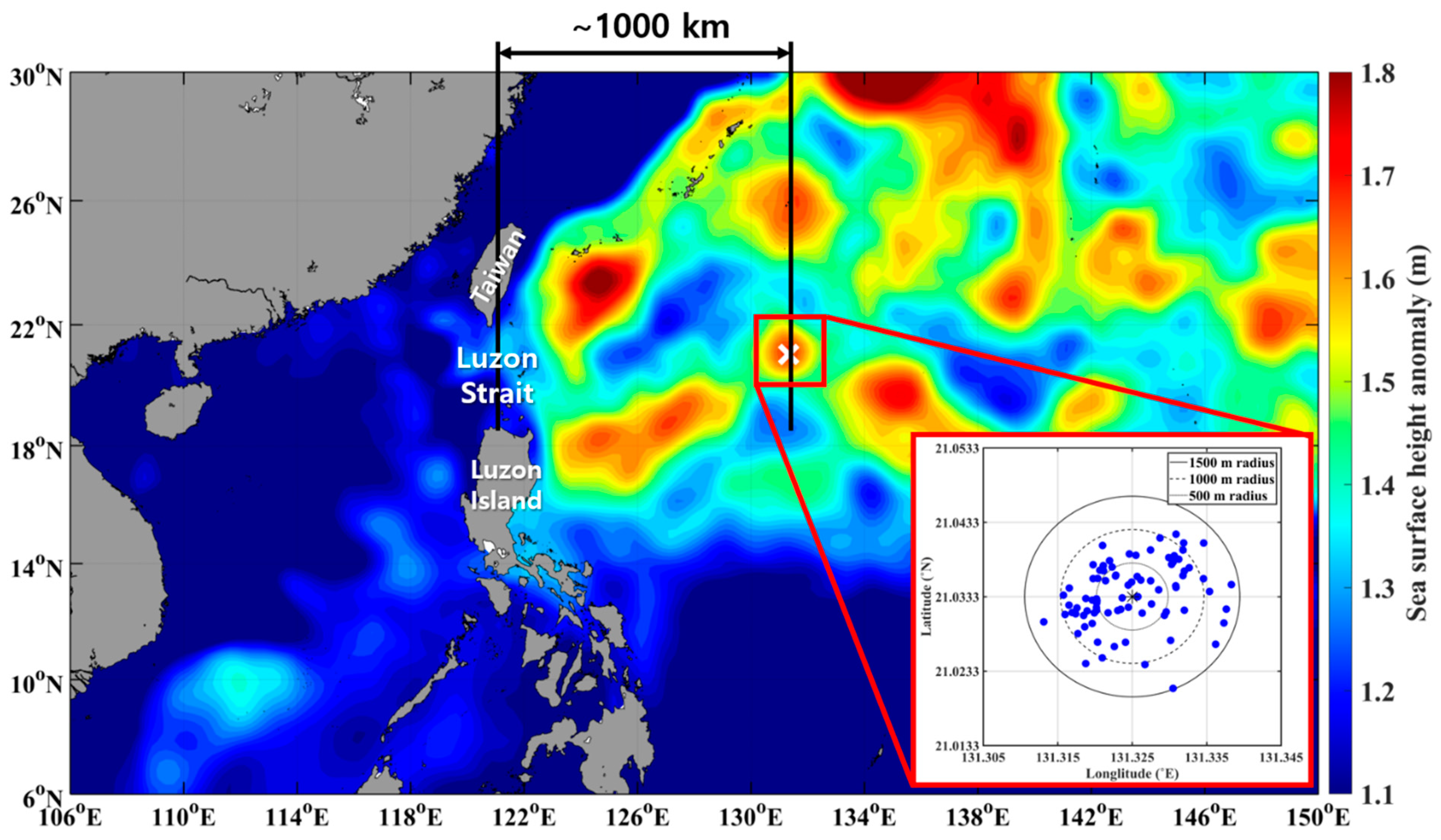
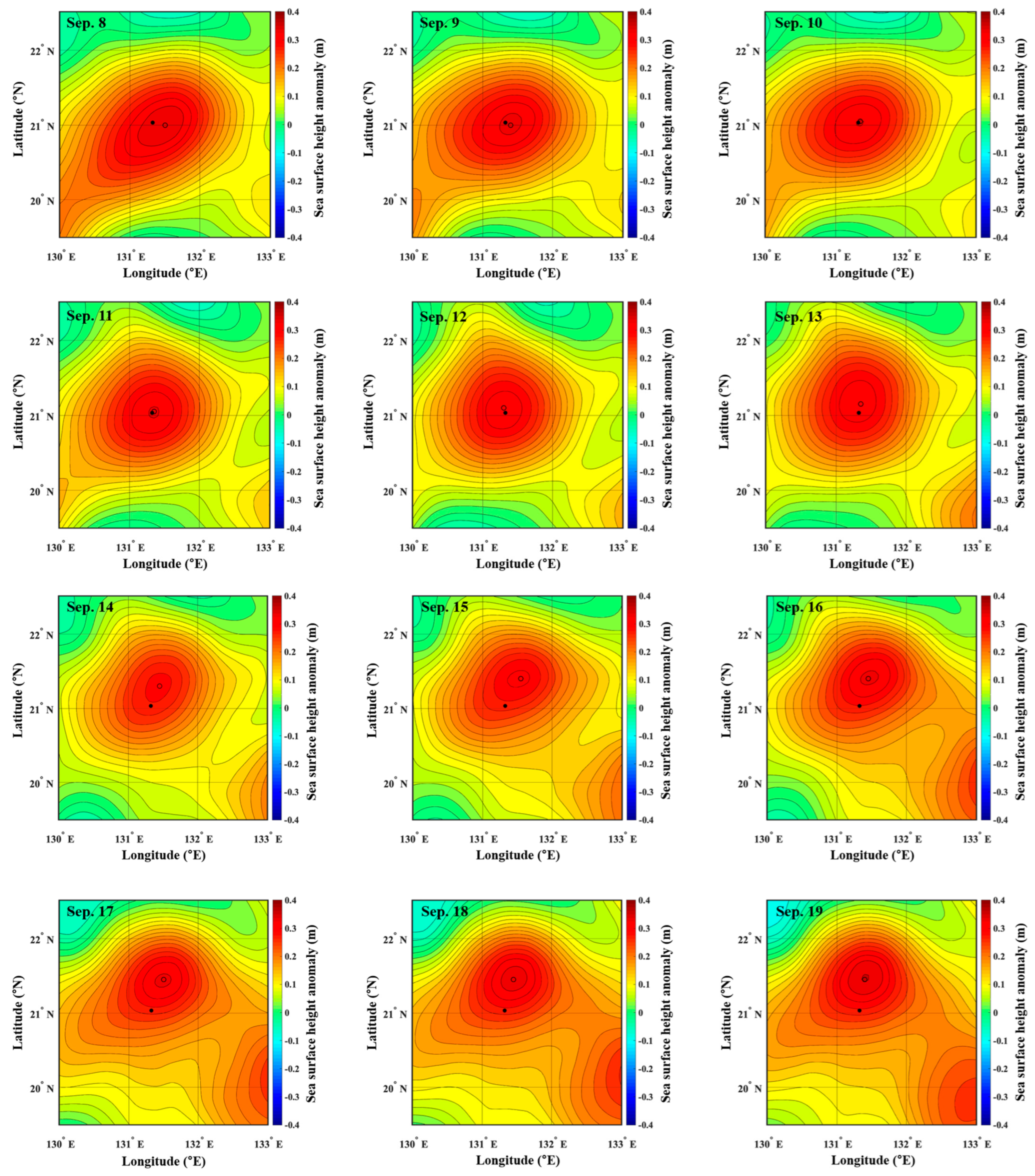
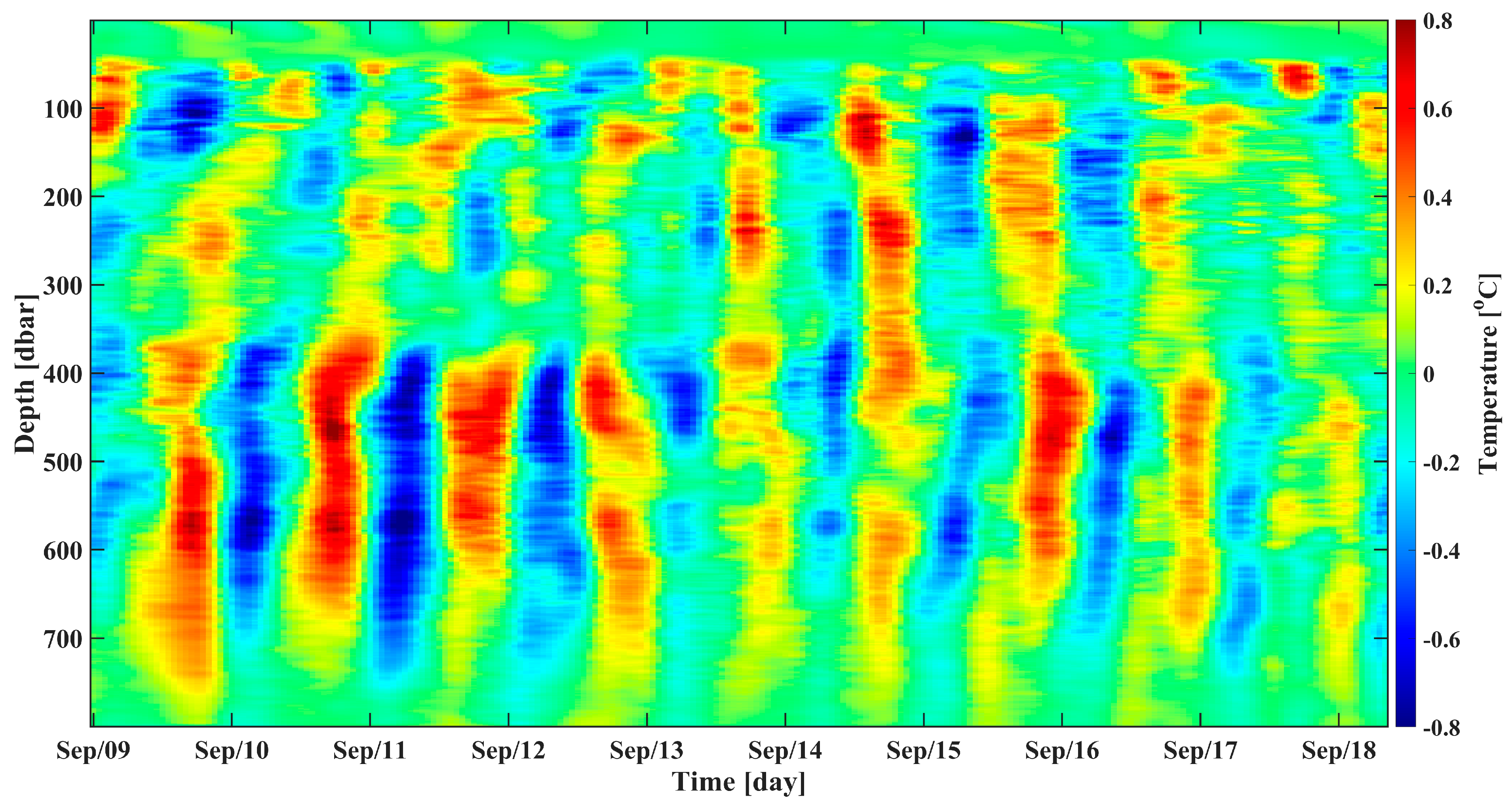
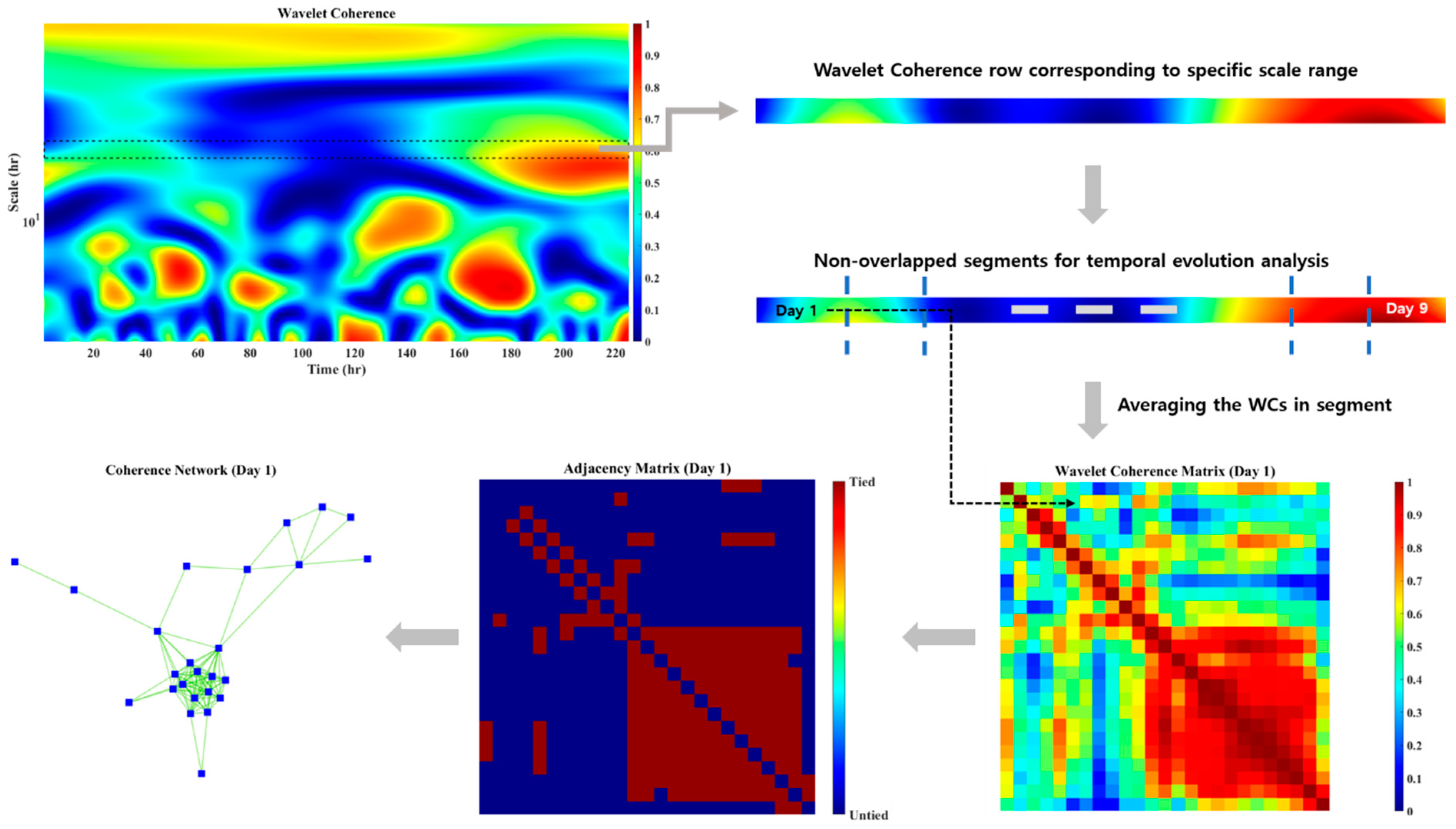

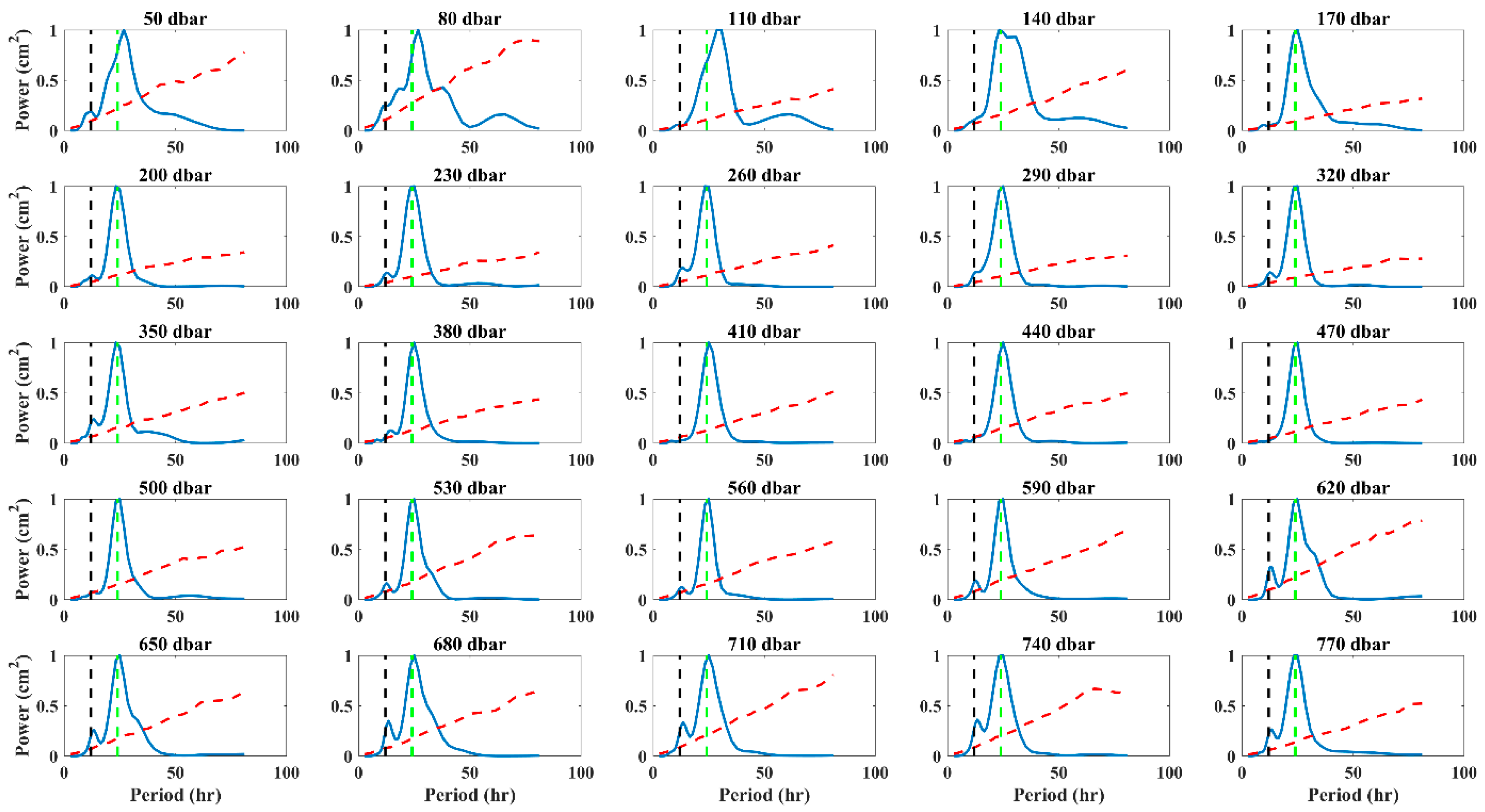

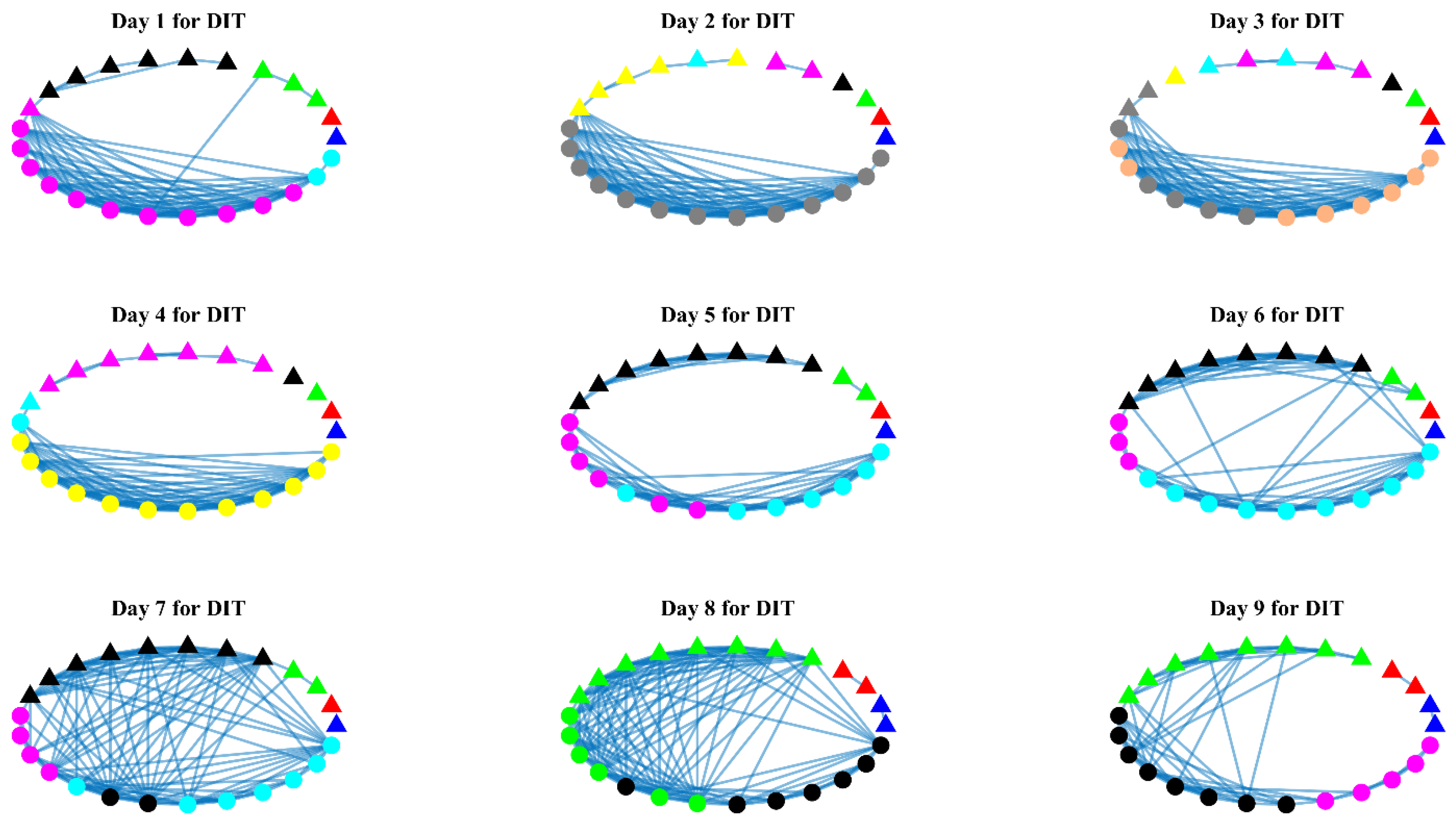


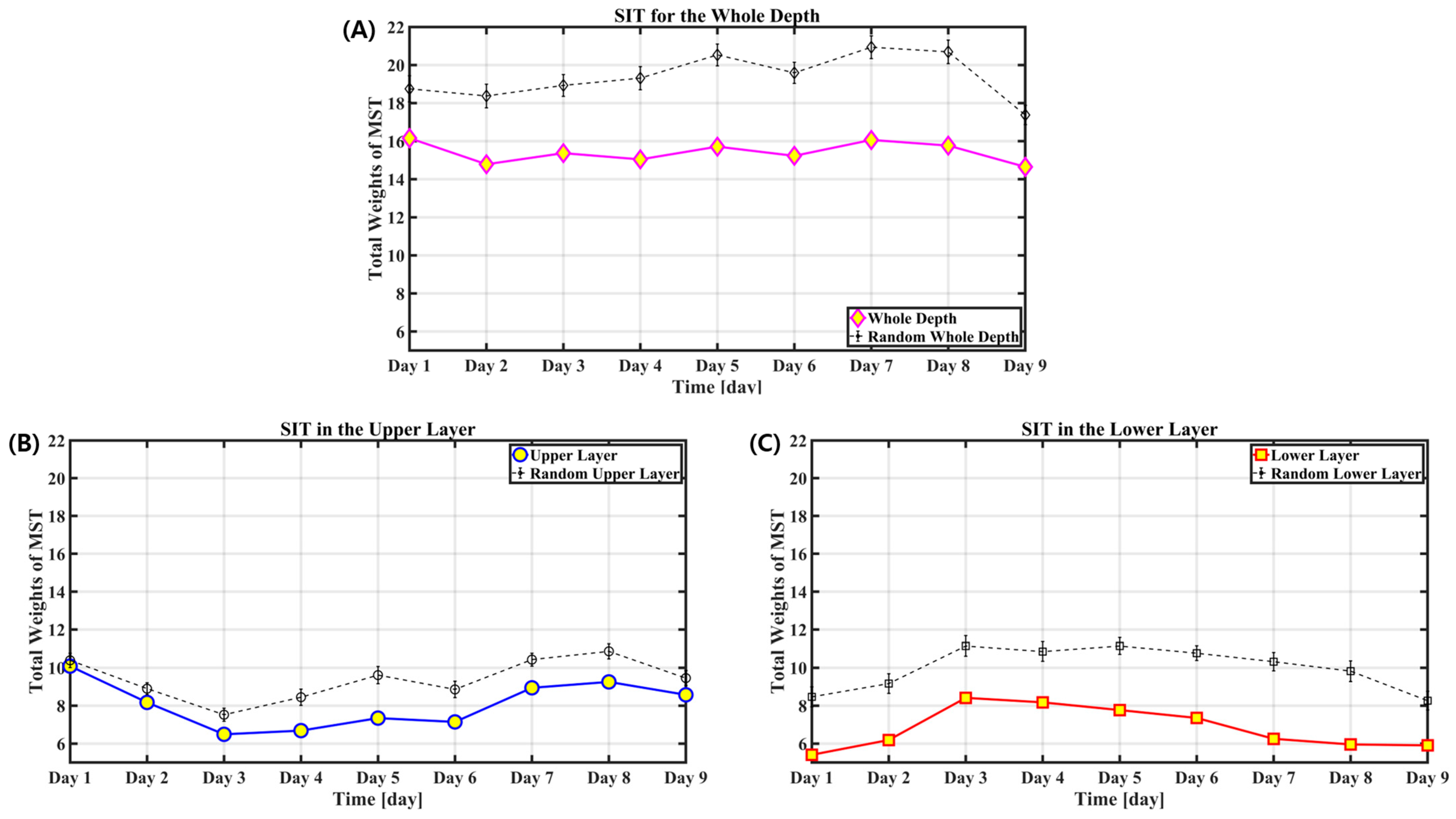
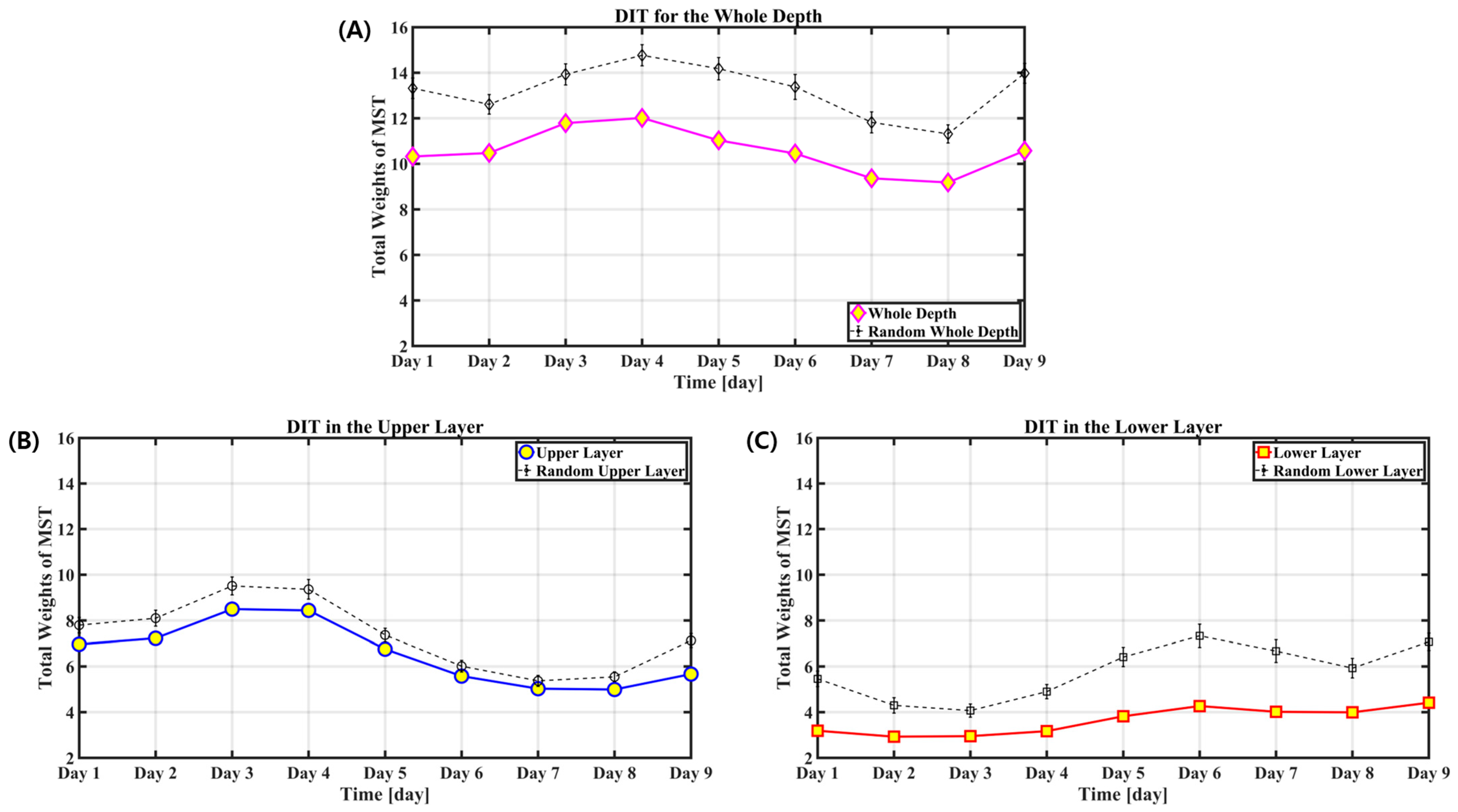


Disclaimer/Publisher’s Note: The statements, opinions and data contained in all publications are solely those of the individual author(s) and contributor(s) and not of MDPI and/or the editor(s). MDPI and/or the editor(s) disclaim responsibility for any injury to people or property resulting from any ideas, methods, instructions or products referred to in the content. |
© 2024 by the authors. Licensee MDPI, Basel, Switzerland. This article is an open access article distributed under the terms and conditions of the Creative Commons Attribution (CC BY) license (https://creativecommons.org/licenses/by/4.0/).
Share and Cite
Lim, G.; Park, J.-J. Examining Modulations of Internal Tides within An Anticyclonic Eddy Using a Wavelet-Coherence Network Approach. Appl. Sci. 2024, 14, 1001. https://doi.org/10.3390/app14031001
Lim G, Park J-J. Examining Modulations of Internal Tides within An Anticyclonic Eddy Using a Wavelet-Coherence Network Approach. Applied Sciences. 2024; 14(3):1001. https://doi.org/10.3390/app14031001
Chicago/Turabian StyleLim, Gyuchang, and Jong-Jin Park. 2024. "Examining Modulations of Internal Tides within An Anticyclonic Eddy Using a Wavelet-Coherence Network Approach" Applied Sciences 14, no. 3: 1001. https://doi.org/10.3390/app14031001
APA StyleLim, G., & Park, J.-J. (2024). Examining Modulations of Internal Tides within An Anticyclonic Eddy Using a Wavelet-Coherence Network Approach. Applied Sciences, 14(3), 1001. https://doi.org/10.3390/app14031001




